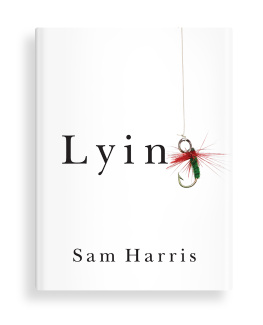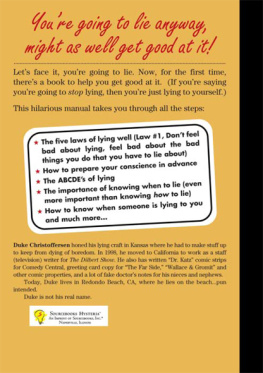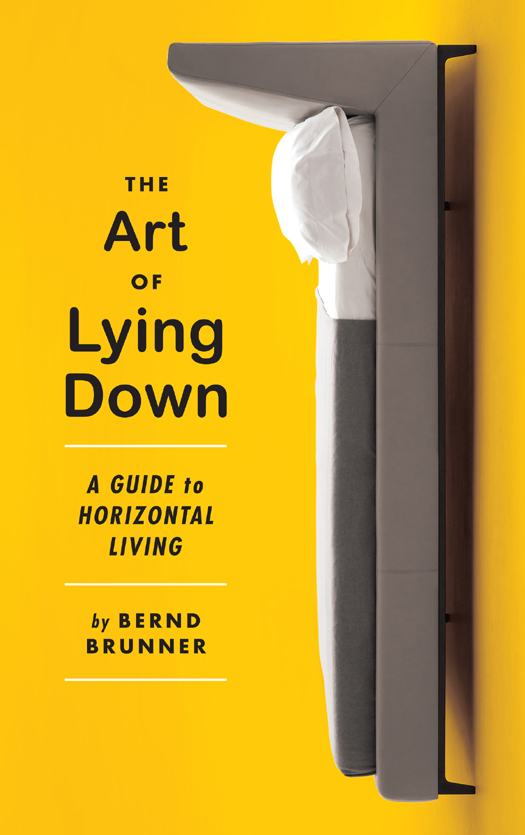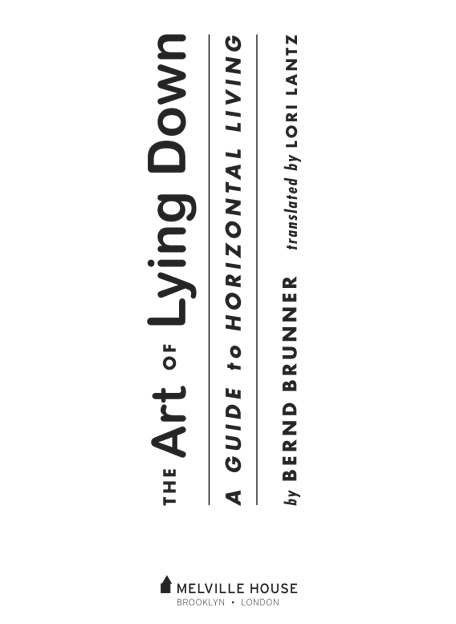
Also by Bernd Brunner
Inventing the Christmas Tree
Moon: A Brief History
Bears: A Brief History
The Ocean at Home: An Illustrated
History of the Aquarium
The Art of Lying Down
Originally published in the German language as
Die Kunst des Liegens: Handbuch der horizontalen
Lebensform by Bernd Brunner
Copyright 2012 by Verlag Kiepenheuer &
Witsch GmbH & Co. KG, Kln / Germany
Translation copyright 2013 by Lori Lantz
First Melville House printing: November 2013
| Melville House Publishing | 8 Blackstock Mews |
| 145 Plymouth Street | and | Islington |
| Brooklyn, NY 11201 | London N4 2BT |
mhpbooks.com facebook.com/mhpbooks @melvillehouse
ISBN: 978-1-61219-310-6 (ebook)
A catalog record is available for this book from the Library of Congress.
v3.1
A thing that cant be done in bed isnt worth doing at all.
Groucho Marx
Contents
Are You Lying Down?
If youre lying down right now, theres no need to defend yourself. We all do it regularly, and often we enjoy it. We lie down to relax, assuming the posture that offers the body the least resistance and demands the least energy. And we perform all sorts of activities this way: we sleep and dream, make love, contemplate, give ourselves over to wistful moods, daydream, and suffer. But theres one thing we rarely do in this state: move around. When we stretch out horizontally, we come the closest we can to remaining still.
In a society attuned to measurable performance, where quickly making and acting on decisions are what matters and people prove themselves by sitting for long hours at their desks and in front of their computers, reclining often goes unappreciated. Even worse, it is seen as proof of indolence or a sign of powerlessness in a fast-changing world. You cant keep up when youre lying down. Those who do anyway are considered weak or criticized for not putting their time to better use. Yet lying down can feel like taking a walk in a thick fog: we often emerge with clearer thoughts than before. As a calculated move to escape the ever-present pressure to be fast and efficient, conscious reclining costs nothing and is yet extremely valuable.
Lying down is the horizontal counterpart of the dreamy rambling of a melancholy flneur, who walks about without pursuing any goal. Someone in repose may wander through town and countryside, too, but generally only in his or her imagination. These fanciful strolls demand a higher level of creativity since no real faces and places show up to stimulate the resting wanderers thoughts.

When we lie on our back and direct our gaze up toward the ceiling or sky, we lose our physical grasp of things and our thoughts soar. Our mental makeup and even the structure of our perception can change with this shift of position. Responses that seemed perfectly natural a few minutes earlier, when we were standing upright, become inexplicable. Questions that were so important appear in a different light when we view them horizontally. Voices and even the ringing of a telephone may no longer reach us with the same urgency as when we are standing. In no other position can certainties suddenly seem less certain. When we lie down, perhaps because we feel overwhelmed, a burden falls from our shoulders. But perception patterns differ, possibly even from person to person. Lin Yutang, the Chinese writer, once claimed that our senses are the keenest in that moment when we are lying down, and he goes on to say that all good music should be listened to in the lying position.
Thinking about what it means to recline involves not only questions of physiology, psychology, and creativity but also the economy of time and the pace of our lives, which the American psychologist Robert Levine once tellingly described as a tangled arrangement of cadences, of perpetually changing rhythms and sequences, stresses and calms, cycles and spikes. If and when lying down is acceptable all depends on the attitudes towards time. We operate in time, and it governs our behavioral cycles like a silent language. In an age and culture like ours, which has internalized a compulsion for constant movement and bred an internal agitation that rules every aspect of our lives, there is little we can do but turn the screws of time and adapt to its demanding rhythm. In places with different rhythms from our own, where activities emerge from whats happening at the moment rather than from what has been planned, we can get a sense of what it means to live within time that follows different laws. In other societies, a moment when nothing seems to be happening may not be seen as a waste of time, but rather as something pleasant and essential to life. Another reason to give the horizontal world a closer look.
The Grammar of Horizontal Orientation
Our bodies are designed for performance well beyond the limited movements we demand of them. We spend far more time sitting and move much less than our ancestors did just a few generations ago. Thanks to our genetic makeup and physical disposition, we are born to vary our movements, from walking to lying down, standing, sitting, and more. Reclining horizontally is just one of these many possibilities, but the urge to give in to the pull of gravity is a strong one. Gravity pulls us toward the earth, and we are constantly negotiating its demands. Although we arent consciously aware of this effortwe are so accustomed to it that we do it automaticallya great deal of our energy is dedicated to our struggle against this elemental physical force.
Lying down and walking or running are counterparts to each other, since one determines the other. Only someone who has walked, hiked, or run to the point of exhaustion can fully appreciate the infinite sense of rest that lying down can bring. Others never fully experience this sensation. But reclining can also present a different purpose: it offers a retreat when the body becomes too heavy to bear. Lying down is like powering down to zero.
We orient ourselves in two directions from the earths surface: vertical and horizontal. When we walk, our connection to the earth is experienced through the soles of our feet, but when we lie down, this contact spreads to the rest of our body. When we are upright, the horizon, the distant line separating sky and earth, promises something beyond what we know but also represents a limit reaching that beyond. It is a fleeting construct that retreats into the distance whenever we try to approach it, a goal that can never be reached.
Lying down is possible to execute in many locations. While a cot or a bed is not essential, reclining does require a stable foundation. If we cant lie down comfortably and are worried about our safetyperhaps because were in danger of falling off the surface, or rolling offwe wont be able to relax. For this reason, the preparations we make for being horizontal shape how we experience this (in)activity. In the end, a persons chosen method of reclining is a response to a particular resting place. The more comfortable we make ourselves by providing the best support for our weight, the greater the renewal we will feel.
















